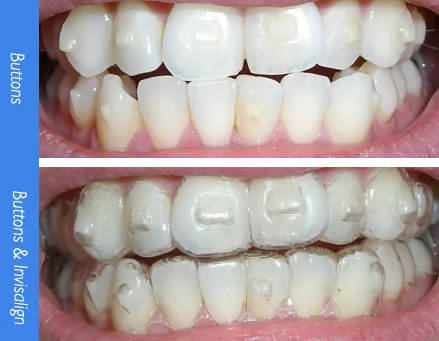Invisalign vs. Traditional Braces: Which Alternative Is Right for You?
When taking into consideration orthodontic treatment, the choice between Invisalign and conventional braces provides a number of crucial aspects that warrant mindful analysis. Invisalign supplies a very discreet choice with detachable aligners, while conventional braces provide a more noticeable yet reliable remedy for serious imbalance.
Introduction of Treatment Options

On the other hand, standard dental braces include steel brackets and cables that are bonded to the teeth. This technique uses continuous stress with time to accomplish placement. While effective for intricate orthodontic issues, conventional dental braces require regular visits for modifications and can present challenges in preserving dental health due to the problem of cleansing around cords and braces.
Both options have their values, and the choice commonly depends upon details oral conditions, way of living preferences, and client conformity. Ultimately, getting in touch with an orthodontic expert is important for determining the most appropriate treatment plan tailored to individual needs. Understanding the nuances of each option can considerably influence the overall success of orthodontic therapy.
Visual Factors To Consider
A substantial factor affecting the option in between Invisalign and conventional braces is the visual charm each therapy uses. Invisalign aligners are crafted from clear plastic, making them practically invisible when put on.
On the other hand, traditional dental braces contain steel brackets and cords, which can be much more recognizable. While improvements in orthodontic modern technology have actually led to the growth of smaller braces and colored elastics, standard braces still preserve an even more noticeable account. For some individuals, the presence of braces might deter them from seeking essential treatment.
Inevitably, the option in between Invisalign and conventional dental braces may hinge on individual choices concerning aesthetic appeals. Clients that focus on discretion usually favor Invisalign, while those who are much less concerned regarding exposure may go with standard braces. Understanding the visual effects of each alternative is vital for making an educated decision that aligns with one's way of life and choices.
Convenience and Convenience

In terms of benefit, Invisalign aligners are removable, allowing clients to enjoy their preferred foods without limitation and preserve ideal oral health. Cleaning and flossing are simplified, as the aligners can be taken out throughout these routines, whereas traditional dental braces need careful maneuvering around braces and cables.
In comparison, typical dental braces necessitate normal changes, making them much less practical for those with hectic routines. Generally, the convenience and convenience of Invisalign make it an enticing choice for many people looking for orthodontic therapy.
Therapy Duration and Performance
While both Invisalign and standard braces work in correcting dental imbalances, the period of treatment can vary considerably in between both choices. Typically, Invisalign treatment can take anywhere from 12 to 18 months, relying on the complexity of the instance. The clear aligners work by slowly changing teeth into their preferred positions, and routine follow-ups with an orthodontist aid ensure development stays on course.
In contrast, standard dental braces frequently need a longer dedication, generally ranging from 18 months to three years. This is due to their fixed nature and the usage of brackets and cables, which can be extra reliable for serious misalignments and intricate instances (Invisalign). The treatment performance of conventional braces is well-documented, as they enable accurate changes and greater control over tooth motion
Ultimately, the selection between Invisalign and typical braces might rest on both the awaited therapy duration and the details oral concerns handy. Consulting with an orthodontist is critical, as they can give customized referrals based upon private needs, making sure the selected method straightens with preferred durations and end results.
Expense Comparison and Insurance Coverage Options
Cost plays a substantial function in the decision-making process for people taking into consideration orthodontic treatment, whether going with Invisalign or typical dental braces. On average, the cost of Invisalign arrays from $3,000 to $8,000, while standard see this braces normally set you back between $2,000 and $6,000. Elements influencing these costs consist of the intricacy of the instance, the period click over here of treatment, and geographical place.
Several dental insurance strategies provide partial insurance coverage for orthodontic therapies, however the specifics can vary commonly. Generally, typical braces might be a lot more frequently covered by insurance policy plans contrasted to Invisalign, which some insurance companies categorize as an aesthetic treatment.
Additionally, a number of orthodontic techniques provide versatile settlement plans, making both therapy alternatives more obtainable. Patients must ask about prospective funding choices and discount rates for ahead of time repayments. Examining the complete cost, consisting of insurance advantages and payment plans, is essential for making a notified choice that aligns with both visual choices and budget factors to consider.

Verdict
In summary, the selection in between Invisalign and typical braces pivots on several aspects, consisting of visual choices, comfort, treatment duration, and price. Invisalign supplies a very discreet, detachable choice that helps with oral health and nutritional versatility, while standard braces may be more ideal for intricate oral problems and frequently come at a reduced cost point. Ultimately, consultation with an orthodontist is vital to analyze private situations and determine one of the most proper treatment option for attaining ideal dental placement.
When thinking about orthodontic treatment, the selection between Invisalign and traditional dental braces provides several vital variables that merit careful examination.Comparing Invisalign and traditional dental braces exposes distinct therapy choices for orthodontic adjustment.While both Invisalign and traditional dental braces are effective in dealing with oral misalignments, the period of treatment can differ significantly in between the two choices.Cost plays a significant role in the decision-making procedure for people considering orthodontic therapy, whether opting for Invisalign or conventional dental braces.In summary, the option in between Invisalign and traditional dental braces pivots on several variables, including visual choices, comfort, treatment my sources period, and expense.
Comments on “Success Stories: How Invisalign Changed Lives and Enhanced Confidence”